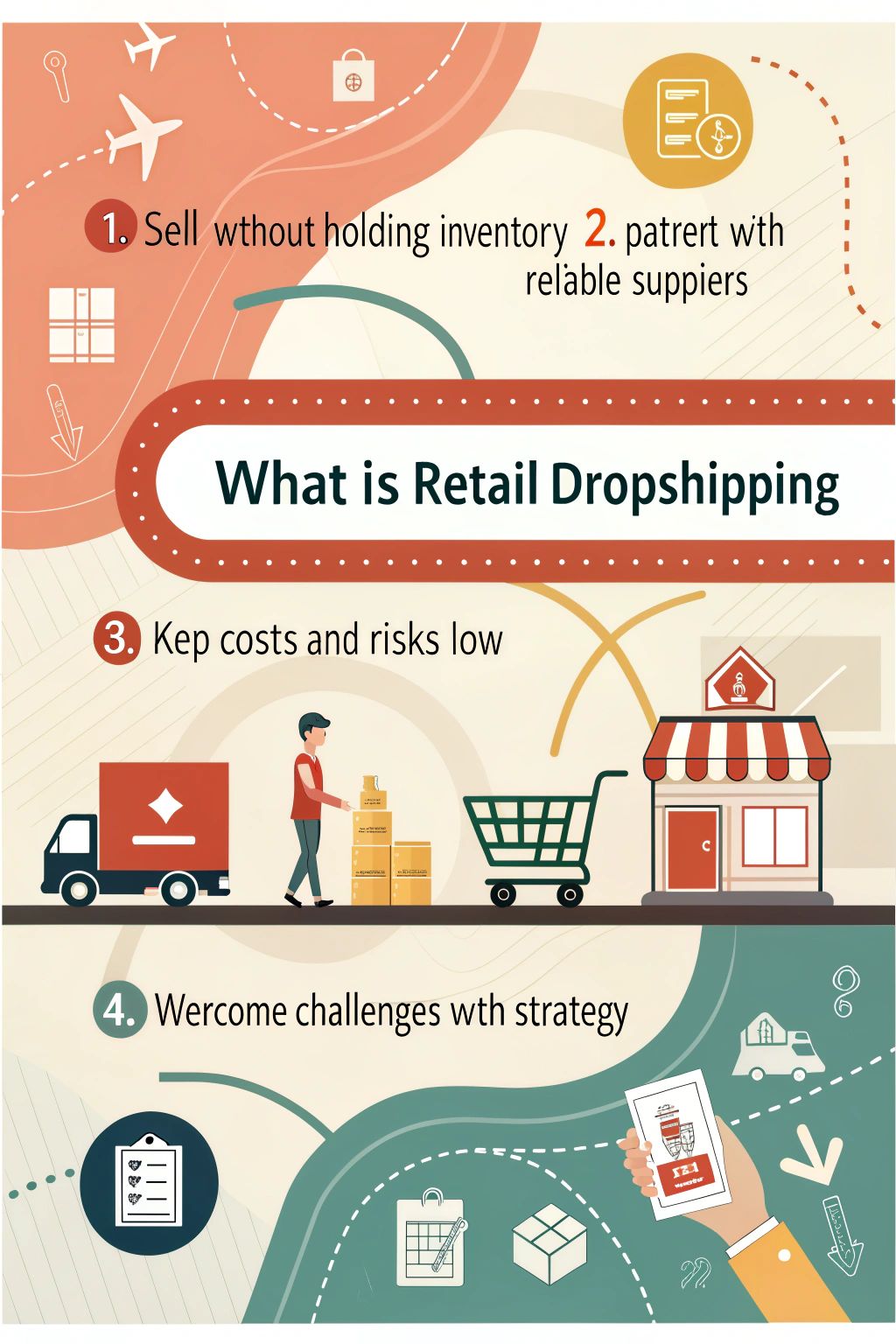Starting an online store can feel overwhelming. Many people worry about buying and storing products or handling shipping. These issues often stop them from starting their dream business.
Retail dropshipping could solve these problems. This model allows sellers to list items online without keeping stock. When a customer orders, the supplier ships the product directly.
This blog explains how retail dropshipping works, its benefits, challenges, and tips for success. Keep reading!
Key Takeaways
- Retail dropshipping lets businesses sell products without holding inventory. Suppliers handle shipping directly to customers.
- Platforms like SmokeDrop help retailers access over 20,000 smoke shop items with no minimum orders and automated tools for order syncing and tracking updates.
- Benefits of dropshipping include low startup costs, no need for inventory management, and flexibility in offering various products.
- Challenges include low profit margins, high competition, limited product quality control, and potential shipping delays.
- Success requires good market research, reliable suppliers like SmokeDrop, strong customer service, and clear shipping strategies.

What Is Retail Dropshipping?

Retail dropshipping is a way to sell products online without keeping them in stock. Instead, a store passes customer orders to suppliers who ship items directly.
[What is Dropshipping and How to Start Using SmokeDrop](https://thesmokedrop.com/what-is-dropshipping-and-how-to-start-using-smokedrop/)
Dropshipping lets online stores sell products without keeping stock. Retailers list items from suppliers, and the supplier ships orders directly to customers. SmokeDrop makes this easy with automated tools and thousands of smoke products like vapes, CBD, and water pipes.
There’s no minimum order for wholesale purchases.
The platform connects well with Shopify, WooCommerce, or BigCommerce. Retailers can quickly import items into their store and keep inventory updated automatically. Orders are processed fast using the app, which also handles tracking updates for customers.
How Does Retail Dropshipping Work?
Retail dropshipping works through a simple process where the retailer sells products without holding any stock—learn how these roles connect and make this model tick!
The role of the retailer
Retailers act as the middle link between customers and suppliers. They list products, like smoke accessories from SmokeDrop’s catalog of over 20,000 items, on their online stores. They manage product catalogs and use ecommerce integration for smooth operations.
They process customer orders without holding inventory. Order fulfillment automation allows retailers to focus on marketing and sales instead of worrying about stock or shipping. Transparency in dropshipping is boosted with automatic inventory syncing and tracking updates from platforms like SmokeDrop.
The role of the supplier
Suppliers play a key part in dropshipping. They provide the products listed by retailers and keep the catalog updated. Platforms like SmokeDrop make this process easier with over 20,000 smoke products and accessories available for wholesale purchasing.
There are no minimum order requirements, so retailers can scale at their own pace.
The supplier handles inventory management, packaging, and shipping processes directly to customers. Automated systems ensure quick order syncing and tracking updates for transparency.
This reduces delays in fulfillment while keeping buyers informed every step of the way—leading into understanding how orders get fulfilled next!
Order fulfillment process
The supplier’s role sets the foundation for smooth order handling. Retailers then manage the next steps to ensure a seamless process.
- Orders placed by customers go directly to the retailer’s online store. This step connects the buyer with available products.
- Automated order syncing sends these details to the supplier quickly and accurately. Retailers don’t have to enter data manually, saving time.
- Tracking number synchronization allows retailers to update customers about their package status. This keeps shipping transparent and builds trust.
- Inventory management becomes simple through tools like SmokeDrop, which updates stock automatically on online stores. Avoiding overselling protects customer satisfaction.
- Retailers can integrate platforms like Shopify or WooCommerce for smooth operation across systems. This streamlines tasks and reduces errors during processing.
- Adding new items becomes easy with product importation features, giving retailers more variety without holding stock physically.
- Fast shipping options promoted by services like SmokeDrop help improve customer experience, leading to better reviews and repeat buyers.
Key Players in the Dropshipping Model
The dropshipping model relies on key roles working together. Each part plays a major role in getting products to customers smoothly.
Manufacturers
Manufacturers create products from raw materials. They are the first step in the dropshipping chain. These makers often sell goods in bulk to wholesalers or distributors, not directly to retailers.
Their goal is production, not marketing or selling small amounts.
Retailers rely on manufacturers for high-quality items. Strong relationships with makers mean reliable inventory and steady supply. Without them, there would be no products for dropshippers to sell online.
Wholesalers
Wholesalers play a key role in dropshipping. They supply products in bulk to retailers, often at lower prices. These wholesale suppliers act as the link between manufacturers and retailers.
They stock inventory so that retailers don’t have to manage it themselves.
SmokeDrop offers access to over 20,000 smoke shop items for retailers. Retailers can buy these products with no minimum order, allowing flexibility in product sourcing. This supplier network simplifies ecommerce by providing reliable dropshipping options without taking on extra inventory costs.
Retailers
Retailers play a key part in dropshipping. They set up online stores on platforms like Shopify or WooCommerce and import products directly through tools like SmokeDrop. Over 20,000 smoke products and accessories are ready to add with no minimum order required.
This allows retailers to offer many options without holding inventory.
Tools from SmokeDrop help manage orders easily. Features include automated fulfillment, tracking updates, and inventory sync for smooth operations. These tools save time while ensuring efficient management of an ecommerce store.
Potential Benefits of Retail Dropshipping
Retail dropshipping offers exciting perks for newcomers and seasoned sellers. It lets businesses grow without the hassle of storing or managing products.
Low startup costs
Starting a dropshipping business needs minimal money. There’s no need to buy inventory upfront. Access to over 20,000 smoke products reduces costs even more. Using platforms like Shopify also cuts software expenses.
No minimum order rules give better control of stock levels. Fully automated services save time on orders and lower operational costs. A user-friendly setup allows businesses to start quickly with little investment needed.
No need for inventory management
Dropshipping removes the hassle of inventory control. Retailers don’t need to store or handle stock. Products are imported directly, cutting out manual tasks. Automatic order syncing keeps everything smooth—no more worrying about inventory oversight.
There’s no minimum order quantity to manage. Automated fulfillment handles orders quickly without physical stock. Tracking numbers sync automatically, making shipping logistics simple and clear.
This streamlines operations for retailers completely!
Flexibility in product offerings
Retailers can choose from over 20,000 smoke shop products using SmokeDrop. This wide range allows them to offer diverse product offerings to meet customer needs.
Products can be imported easily into online stores like Shopify or WooCommerce. There are no minimum order requirements, giving retailers inventory management flexibility. Automated order syncing ensures quick and efficient processing, letting businesses focus on growth.
Challenges of Retail Dropshipping
Retail dropshipping has its tricky parts—profit margins can be thin, and competition is tough. Keep reading to discover how to tackle these issues head-on!
Low profit margins
Dropshipping often struggles with low profit margins. High market competition forces sellers to keep prices low. Wholesale purchasing of cheap products can shrink earnings further.
Even automating order fulfillment cuts costs but doesn’t boost profits much.
Fast shipping adds extra costs, eating into already thin margins. Managing large product catalogs can increase inventory turnover but strain profitability. Platform integration (like Shopify or WooCommerce) makes processes smoother yet offers no direct profit growth advantage.
High competition creates other challenges for retailers…
High competition
High competition makes retail dropshipping tough. Retailers must work hard to attract new buyers and keep them coming back for repeat sales. A wide product catalog helps stand out in a crowded ecommerce market.
Automated order fulfillment and inventory sync save time, helping businesses focus on growth. Integration solutions simplify operations, making it easier to manage high demands. Flexible inventory control with no minimum orders helps retailers scale faster while staying ahead of competitors.
Limited control over product quality
Retailers lack control over product quality in dropshipping. Suppliers handle production and shipping, making quality assurance hard. Flaws or inconsistencies can upset customers and hurt repeated sales.
Automation helps streamline order fulfillment but does not guarantee reliable products.
Good supplier relationships are key to solving these issues. Clear communication can help address problems quickly. Retailers must also manage customer expectations about product standards to reduce complaints or refunds.
This challenge ties closely with other struggles like shipping delays and high competition ahead.
Shipping and fulfillment issues
Shipping can get tricky with dropshipping. Delays happen because retailers don’t control shipping times. Suppliers often ship from far places, leading to slow deliveries and unhappy customers.
Tracking numbers help but may not always update quickly enough.
Order mistakes also cause frustration. Incorrect items or missing packages hurt the customer experience. Automated order syncing improves accuracy by updating inventory in real-time, reducing such errors.
Fast product import tools help speed up processing, but fulfillment still depends on suppliers’ efficiency.
Tips for Succeeding in Retail Dropshipping
Success in retail dropshipping takes planning and smart choices. Focus on building strong systems and making the customer happy every step of the way.
Conduct thorough market research
Study ecommerce trends and the retail industry before starting. Learn about consumer behavior and target audience needs. Know what products sell best in your chosen niche. Check market analysis reports to spot popular items or gaps.
Look at competitors and their pricing strategy. Find out who their suppliers are and how they fulfill orders. Use supply chain management tools to track product sourcing options. Stay updated on market trends for better decisions about inventory choices, leading into choosing reliable suppliers next!
Choose reliable suppliers
Pick suppliers that offer over 20,000 products for variety. Platforms like SmokeDrop can help with quick product imports and a simplified dropshipping process. Access to automated order syncing ensures smooth processing and tracking updates.
Good suppliers work with Shopify, WooCommerce, or BigCommerce for easy integration. Wholesale purchasing with no minimum orders allows flexible inventory management. Reliable options also provide inventory synchronization and automated fulfillment services to save time.
Focus on customer service
Reliable suppliers help keep things running smoothly, but customer service keeps buyers happy. Automated order fulfillment frees up time to handle customer inquiries quickly. Buyers feel valued when their questions get answered fast.
Tracking number sync helps customers see where their orders are. It builds trust and boosts satisfaction. A wide product variety also meets customer demand, which leads to more repeat purchases.
Clear updates on inventory and shipping reduce confusion and improve loyalty.
Optimize shipping strategies
Strong customer service builds trust, but smooth shipping keeps customers happy. Automated order fulfillment speeds up the process and ensures quick and accurate deliveries. Retailers can sync tracking numbers across suppliers, stores, and buyers to improve shipping transparency.
Platforms like Shopify or BigCommerce help streamline operations with seamless integration. Bulk product imports reduce errors in inventory management and shipping steps. Wholesale purchasing without minimums allows flexibility for scaling inventory as needed.
Alternatives to Dropshipping
There are other ways to run an online store without dropshipping. These options let retailers manage their business differently while still meeting customer needs.
Third-party fulfillment services
Third-party fulfillment services handle storage, packing, and shipping for businesses. These services work well as dropshipping alternatives, offering solutions like quick order processing and accurate tracking updates.
Companies can save time by outsourcing tasks like inventory management. This allows retailers to focus on product catalog management or customer service.
SmokeDrop integrates with platforms like Shopify and WooCommerce for automation. It streamlines order syncing, ensuring smooth ecommerce platform integration. Retailers using such services benefit from faster shipping without needing their own warehouses or large budgets for logistics.
Creating your own branded products
Selling your own branded products can boost a business. Private labeling or white labeling allows retailers to put their name on existing products. This creates a unique identity for the store while offering exclusive items to customers.
Sourcing from manufacturers or wholesalers helps keep costs low. Retailers can then focus on product design and development. Adding logos, colors, or packaging makes each item stand out in the market.
Branding builds trust with buyers and sets you apart from competitors.
Affiliate marketing opportunities
Affiliate marketing offers a great way to earn. Retailers partner with programs to promote products online. Each sale made through shared links earns the retailer a commission. This approach works well for dropshippers who want extra income streams.
Joining affiliate networks can boost visibility and revenue. Platforms like Amazon Associates or ShareASale help connect businesses with partners easily. These programs don’t require inventory, making them low-risk options for beginners in eCommerce partnerships.
Is Retail Dropshipping Right for You?
Thinking about retail dropshipping? It’s key to weigh your goals and resources before jumping in.
Assessing your business goals
Set clear goals for your dropshipping business. Focus on how product diversification can align with these goals. Access to 20,000 smoke products allows flexibility in inventory control and supports growth needs.
Make sure your plan includes efficient order management through timesaving automation.
Streamlining operations is key for strategic growth. Automated tools like SmokeDrop help sync inventory, saving time and effort. Use e-commerce integration to grow your business easily while keeping costs low.
Considering your budget and resources
Plan your spending carefully. Retail dropshipping has low startup costs, but other expenses can add up. For example, you may need to pay for an ecommerce platform or advertising tools.
Use resources wisely to grow your online store. Research supplier relationships and shipping logistics before starting. Focus on profit margins to ensure the business model is worth it for you.
Understanding your target market
Know your customers well to build a strong dropshipping business. Study customer behavior and figure out what they like, need, and expect. Use retail market analysis to spot trends in ecommerce market trends or consumer preferences.
Check customer demographics such as age, income levels, or locations. Break them into smaller groups using market segmentation. These steps help create a better retail sales strategy for your target audience.
Conclusion
Retail dropshipping offers a simple way to run an online store. It allows retailers to sell products without holding inventory. Suppliers handle shipping, making the process easy and fast.
This business model saves time and reduces startup costs. Challenges like low profits or shipping issues require careful planning. Picking good suppliers and offering great service can boost success.
Anyone ready to work smart can thrive in this field!
FAQs
1. What is retail dropshipping?
Retail dropshipping is a business model where you sell products without keeping them in stock. When someone buys from your store, you order the product from a supplier who ships it directly to the customer.
2. How does retail dropshipping work?
You set up an online store and list products for sale. When customers place orders, you buy the items from suppliers at wholesale prices, and they handle shipping to your buyers.
3. Do I need to keep inventory with dropshipping?
No, that’s the best part! You don’t need to store or manage inventory—your supplier takes care of it all while you focus on marketing and sales.
4. Is retail dropshipping easy for beginners?
It can be! You don’t need big investments or warehouses to start. But remember—success depends on choosing good suppliers, finding popular products, and giving great customer service.




